Comprehensive Research Paper: Wireless Electric Vehicle Technologies
VerifiedAdded on 2020/03/16
|19
|5177
|37
Report
AI Summary
This research paper provides a comprehensive overview of wireless electric vehicles (WEVs), exploring the benefits and technological advancements that make them a preferred alternative to wired electric vehicles and gasoline-powered vehicles. The paper focuses on the wireless power transfer (WPT) technologies, including inductive coupling, magnetic resonance, and magnetic gear, discussing their principles, classifications, limitations, and advantages. It addresses the environmental concerns associated with gasoline engines and the limitations of current battery technology in electric vehicles. The paper also examines the technical issues, latest developments, and challenges associated with WEVs, particularly focusing on two designs: magnetic coupled resonance and magnetic gear wireless power transfer. The research highlights the importance of wireless charging in improving the range and convenience of electric vehicles, making a case for their potential in reducing greenhouse gas emissions and promoting sustainable transportation.
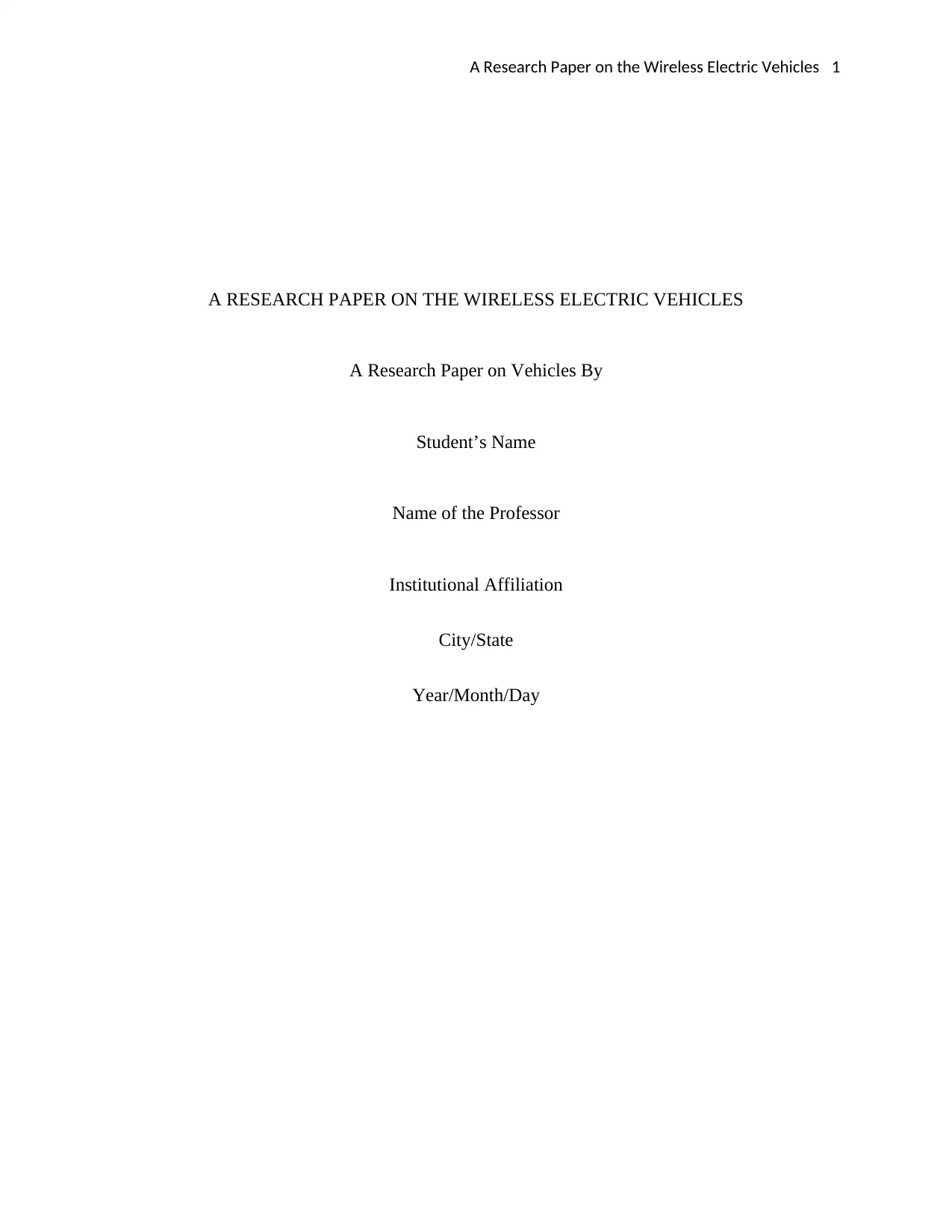
A Research Paper on the Wireless Electric Vehicles 1
A RESEARCH PAPER ON THE WIRELESS ELECTRIC VEHICLES
A Research Paper on Vehicles By
Student’s Name
Name of the Professor
Institutional Affiliation
City/State
Year/Month/Day
A RESEARCH PAPER ON THE WIRELESS ELECTRIC VEHICLES
A Research Paper on Vehicles By
Student’s Name
Name of the Professor
Institutional Affiliation
City/State
Year/Month/Day
Paraphrase This Document
Need a fresh take? Get an instant paraphrase of this document with our AI Paraphraser
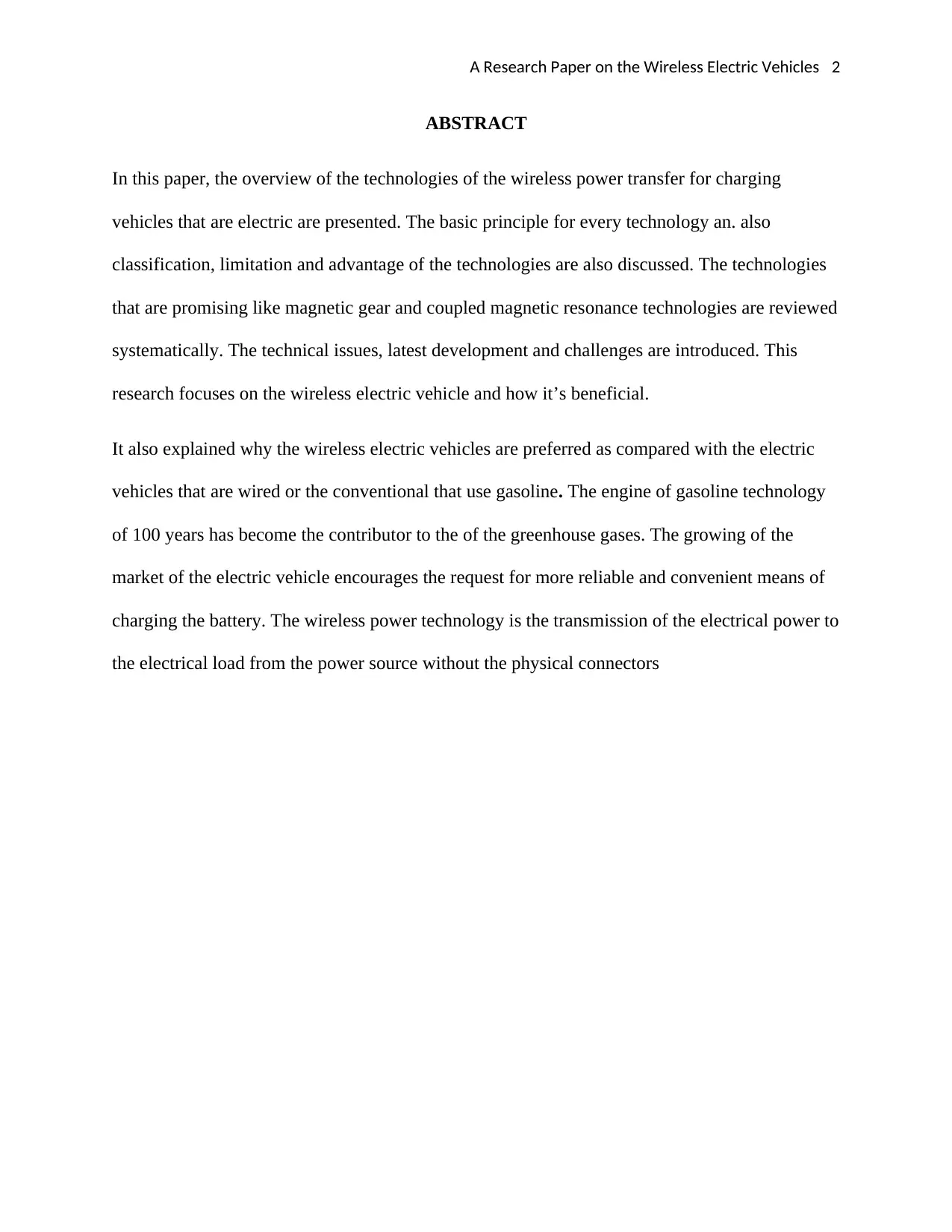
A Research Paper on the Wireless Electric Vehicles 2
ABSTRACT
In this paper, the overview of the technologies of the wireless power transfer for charging
vehicles that are electric are presented. The basic principle for every technology an. also
classification, limitation and advantage of the technologies are also discussed. The technologies
that are promising like magnetic gear and coupled magnetic resonance technologies are reviewed
systematically. The technical issues, latest development and challenges are introduced. This
research focuses on the wireless electric vehicle and how it’s beneficial.
It also explained why the wireless electric vehicles are preferred as compared with the electric
vehicles that are wired or the conventional that use gasoline. The engine of gasoline technology
of 100 years has become the contributor to the of the greenhouse gases. The growing of the
market of the electric vehicle encourages the request for more reliable and convenient means of
charging the battery. The wireless power technology is the transmission of the electrical power to
the electrical load from the power source without the physical connectors
ABSTRACT
In this paper, the overview of the technologies of the wireless power transfer for charging
vehicles that are electric are presented. The basic principle for every technology an. also
classification, limitation and advantage of the technologies are also discussed. The technologies
that are promising like magnetic gear and coupled magnetic resonance technologies are reviewed
systematically. The technical issues, latest development and challenges are introduced. This
research focuses on the wireless electric vehicle and how it’s beneficial.
It also explained why the wireless electric vehicles are preferred as compared with the electric
vehicles that are wired or the conventional that use gasoline. The engine of gasoline technology
of 100 years has become the contributor to the of the greenhouse gases. The growing of the
market of the electric vehicle encourages the request for more reliable and convenient means of
charging the battery. The wireless power technology is the transmission of the electrical power to
the electrical load from the power source without the physical connectors
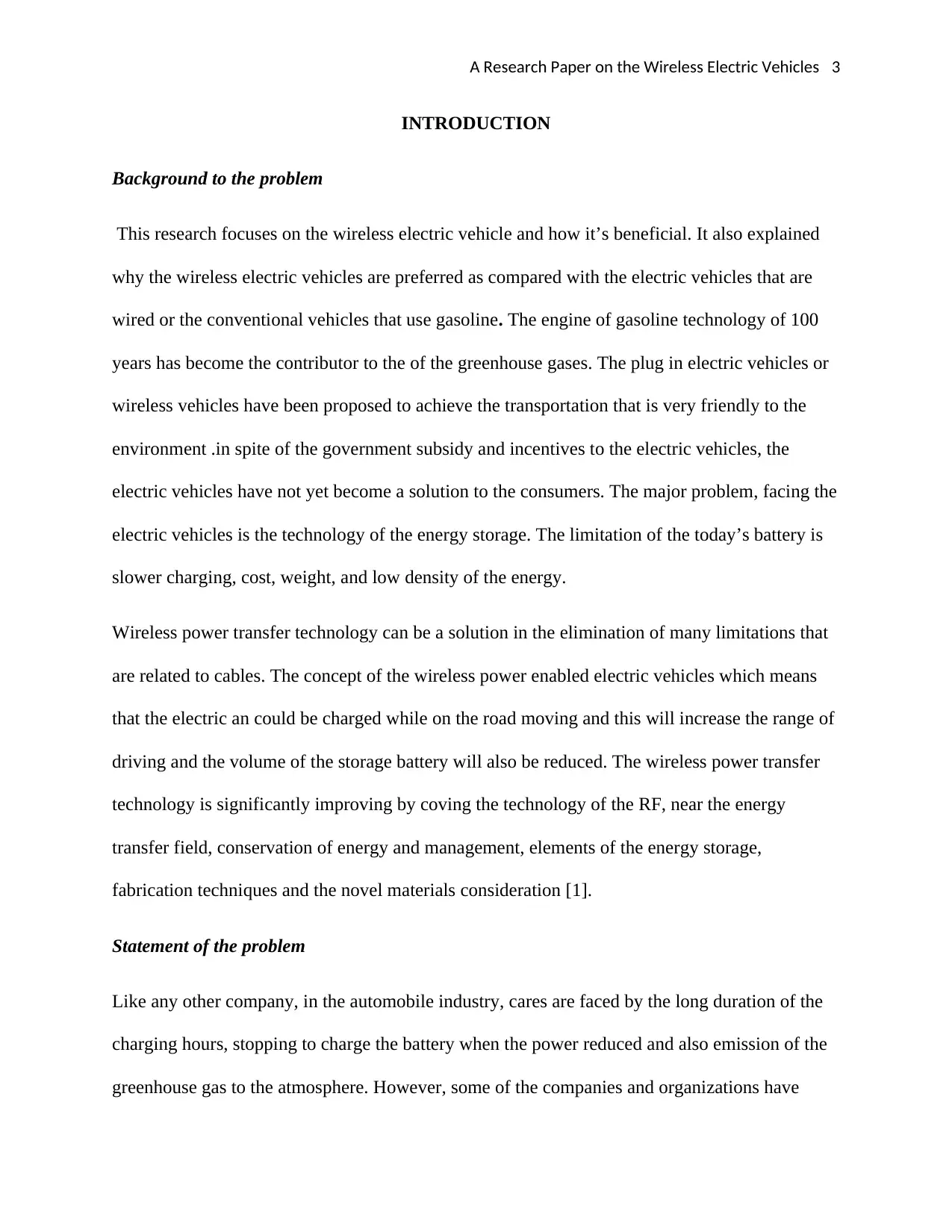
A Research Paper on the Wireless Electric Vehicles 3
INTRODUCTION
Background to the problem
This research focuses on the wireless electric vehicle and how it’s beneficial. It also explained
why the wireless electric vehicles are preferred as compared with the electric vehicles that are
wired or the conventional vehicles that use gasoline. The engine of gasoline technology of 100
years has become the contributor to the of the greenhouse gases. The plug in electric vehicles or
wireless vehicles have been proposed to achieve the transportation that is very friendly to the
environment .in spite of the government subsidy and incentives to the electric vehicles, the
electric vehicles have not yet become a solution to the consumers. The major problem, facing the
electric vehicles is the technology of the energy storage. The limitation of the today’s battery is
slower charging, cost, weight, and low density of the energy.
Wireless power transfer technology can be a solution in the elimination of many limitations that
are related to cables. The concept of the wireless power enabled electric vehicles which means
that the electric an could be charged while on the road moving and this will increase the range of
driving and the volume of the storage battery will also be reduced. The wireless power transfer
technology is significantly improving by coving the technology of the RF, near the energy
transfer field, conservation of energy and management, elements of the energy storage,
fabrication techniques and the novel materials consideration [1].
Statement of the problem
Like any other company, in the automobile industry, cares are faced by the long duration of the
charging hours, stopping to charge the battery when the power reduced and also emission of the
greenhouse gas to the atmosphere. However, some of the companies and organizations have
INTRODUCTION
Background to the problem
This research focuses on the wireless electric vehicle and how it’s beneficial. It also explained
why the wireless electric vehicles are preferred as compared with the electric vehicles that are
wired or the conventional vehicles that use gasoline. The engine of gasoline technology of 100
years has become the contributor to the of the greenhouse gases. The plug in electric vehicles or
wireless vehicles have been proposed to achieve the transportation that is very friendly to the
environment .in spite of the government subsidy and incentives to the electric vehicles, the
electric vehicles have not yet become a solution to the consumers. The major problem, facing the
electric vehicles is the technology of the energy storage. The limitation of the today’s battery is
slower charging, cost, weight, and low density of the energy.
Wireless power transfer technology can be a solution in the elimination of many limitations that
are related to cables. The concept of the wireless power enabled electric vehicles which means
that the electric an could be charged while on the road moving and this will increase the range of
driving and the volume of the storage battery will also be reduced. The wireless power transfer
technology is significantly improving by coving the technology of the RF, near the energy
transfer field, conservation of energy and management, elements of the energy storage,
fabrication techniques and the novel materials consideration [1].
Statement of the problem
Like any other company, in the automobile industry, cares are faced by the long duration of the
charging hours, stopping to charge the battery when the power reduced and also emission of the
greenhouse gas to the atmosphere. However, some of the companies and organizations have
⊘ This is a preview!⊘
Do you want full access?
Subscribe today to unlock all pages.

Trusted by 1+ million students worldwide
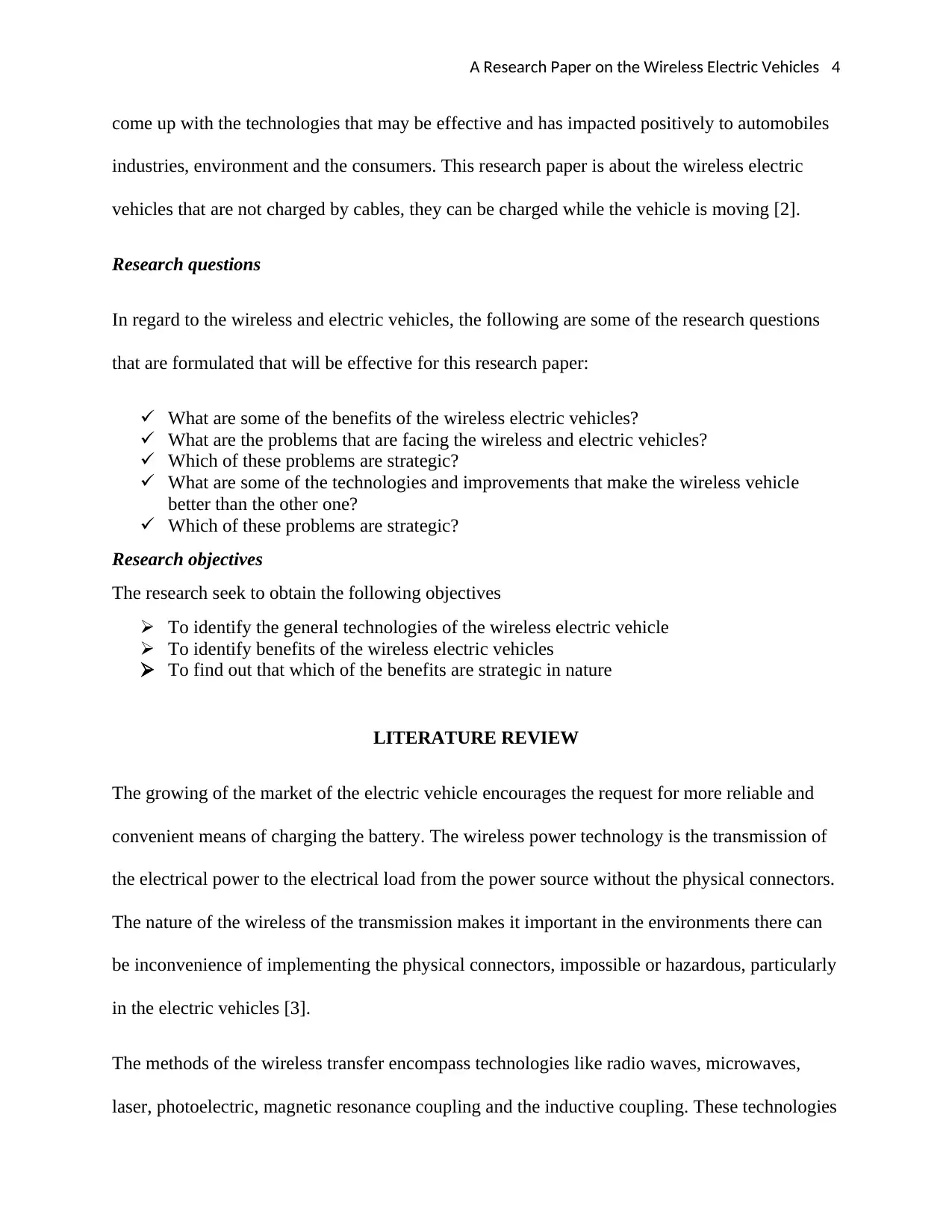
A Research Paper on the Wireless Electric Vehicles 4
come up with the technologies that may be effective and has impacted positively to automobiles
industries, environment and the consumers. This research paper is about the wireless electric
vehicles that are not charged by cables, they can be charged while the vehicle is moving [2].
Research questions
In regard to the wireless and electric vehicles, the following are some of the research questions
that are formulated that will be effective for this research paper:
What are some of the benefits of the wireless electric vehicles?
What are the problems that are facing the wireless and electric vehicles?
Which of these problems are strategic?
What are some of the technologies and improvements that make the wireless vehicle
better than the other one?
Which of these problems are strategic?
Research objectives
The research seek to obtain the following objectives
To identify the general technologies of the wireless electric vehicle
To identify benefits of the wireless electric vehicles
To find out that which of the benefits are strategic in nature
LITERATURE REVIEW
The growing of the market of the electric vehicle encourages the request for more reliable and
convenient means of charging the battery. The wireless power technology is the transmission of
the electrical power to the electrical load from the power source without the physical connectors.
The nature of the wireless of the transmission makes it important in the environments there can
be inconvenience of implementing the physical connectors, impossible or hazardous, particularly
in the electric vehicles [3].
The methods of the wireless transfer encompass technologies like radio waves, microwaves,
laser, photoelectric, magnetic resonance coupling and the inductive coupling. These technologies
come up with the technologies that may be effective and has impacted positively to automobiles
industries, environment and the consumers. This research paper is about the wireless electric
vehicles that are not charged by cables, they can be charged while the vehicle is moving [2].
Research questions
In regard to the wireless and electric vehicles, the following are some of the research questions
that are formulated that will be effective for this research paper:
What are some of the benefits of the wireless electric vehicles?
What are the problems that are facing the wireless and electric vehicles?
Which of these problems are strategic?
What are some of the technologies and improvements that make the wireless vehicle
better than the other one?
Which of these problems are strategic?
Research objectives
The research seek to obtain the following objectives
To identify the general technologies of the wireless electric vehicle
To identify benefits of the wireless electric vehicles
To find out that which of the benefits are strategic in nature
LITERATURE REVIEW
The growing of the market of the electric vehicle encourages the request for more reliable and
convenient means of charging the battery. The wireless power technology is the transmission of
the electrical power to the electrical load from the power source without the physical connectors.
The nature of the wireless of the transmission makes it important in the environments there can
be inconvenience of implementing the physical connectors, impossible or hazardous, particularly
in the electric vehicles [3].
The methods of the wireless transfer encompass technologies like radio waves, microwaves,
laser, photoelectric, magnetic resonance coupling and the inductive coupling. These technologies
Paraphrase This Document
Need a fresh take? Get an instant paraphrase of this document with our AI Paraphraser
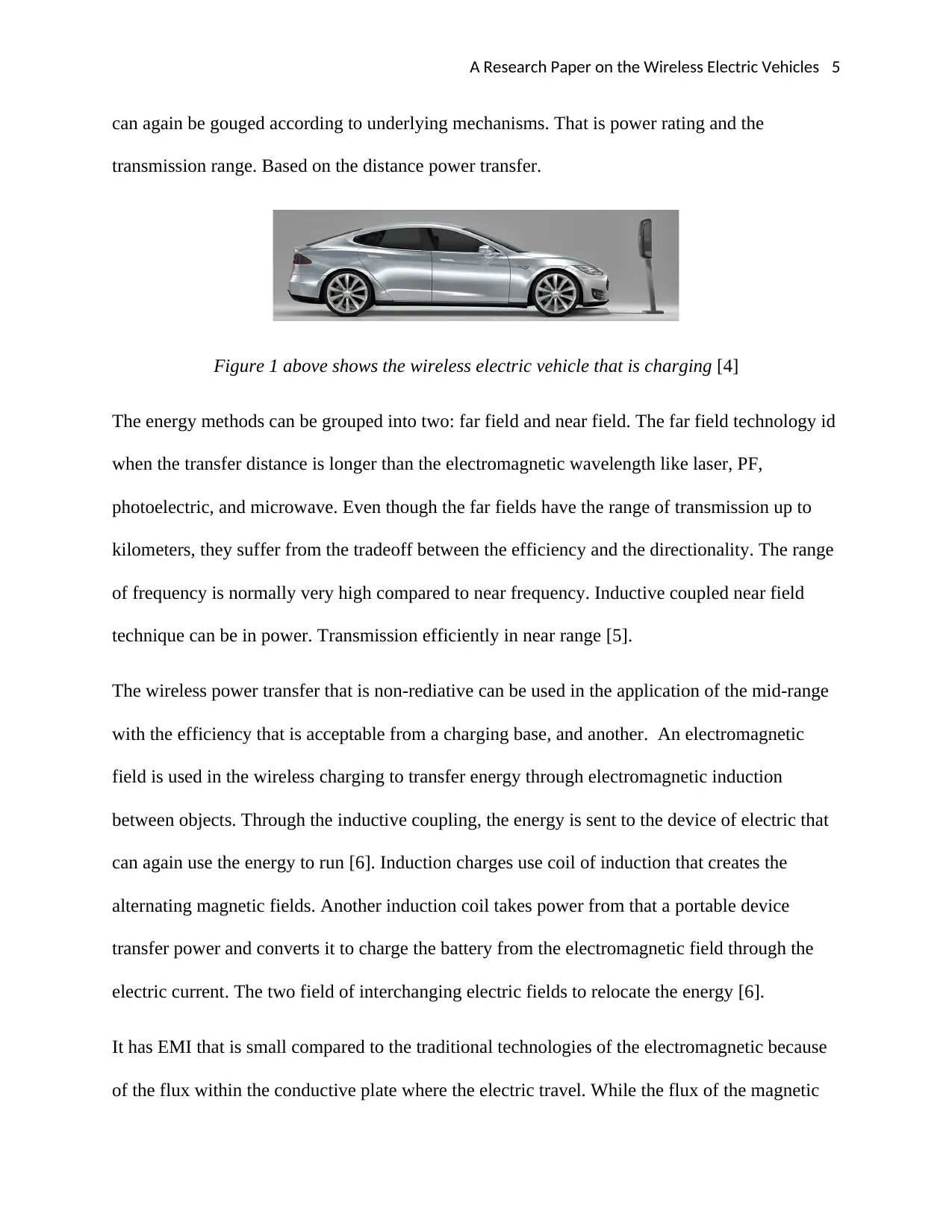
A Research Paper on the Wireless Electric Vehicles 5
can again be gouged according to underlying mechanisms. That is power rating and the
transmission range. Based on the distance power transfer.
Figure 1 above shows the wireless electric vehicle that is charging [4]
The energy methods can be grouped into two: far field and near field. The far field technology id
when the transfer distance is longer than the electromagnetic wavelength like laser, PF,
photoelectric, and microwave. Even though the far fields have the range of transmission up to
kilometers, they suffer from the tradeoff between the efficiency and the directionality. The range
of frequency is normally very high compared to near frequency. Inductive coupled near field
technique can be in power. Transmission efficiently in near range [5].
The wireless power transfer that is non-rediative can be used in the application of the mid-range
with the efficiency that is acceptable from a charging base, and another. An electromagnetic
field is used in the wireless charging to transfer energy through electromagnetic induction
between objects. Through the inductive coupling, the energy is sent to the device of electric that
can again use the energy to run [6]. Induction charges use coil of induction that creates the
alternating magnetic fields. Another induction coil takes power from that a portable device
transfer power and converts it to charge the battery from the electromagnetic field through the
electric current. The two field of interchanging electric fields to relocate the energy [6].
It has EMI that is small compared to the traditional technologies of the electromagnetic because
of the flux within the conductive plate where the electric travel. While the flux of the magnetic
can again be gouged according to underlying mechanisms. That is power rating and the
transmission range. Based on the distance power transfer.
Figure 1 above shows the wireless electric vehicle that is charging [4]
The energy methods can be grouped into two: far field and near field. The far field technology id
when the transfer distance is longer than the electromagnetic wavelength like laser, PF,
photoelectric, and microwave. Even though the far fields have the range of transmission up to
kilometers, they suffer from the tradeoff between the efficiency and the directionality. The range
of frequency is normally very high compared to near frequency. Inductive coupled near field
technique can be in power. Transmission efficiently in near range [5].
The wireless power transfer that is non-rediative can be used in the application of the mid-range
with the efficiency that is acceptable from a charging base, and another. An electromagnetic
field is used in the wireless charging to transfer energy through electromagnetic induction
between objects. Through the inductive coupling, the energy is sent to the device of electric that
can again use the energy to run [6]. Induction charges use coil of induction that creates the
alternating magnetic fields. Another induction coil takes power from that a portable device
transfer power and converts it to charge the battery from the electromagnetic field through the
electric current. The two field of interchanging electric fields to relocate the energy [6].
It has EMI that is small compared to the traditional technologies of the electromagnetic because
of the flux within the conductive plate where the electric travel. While the flux of the magnetic
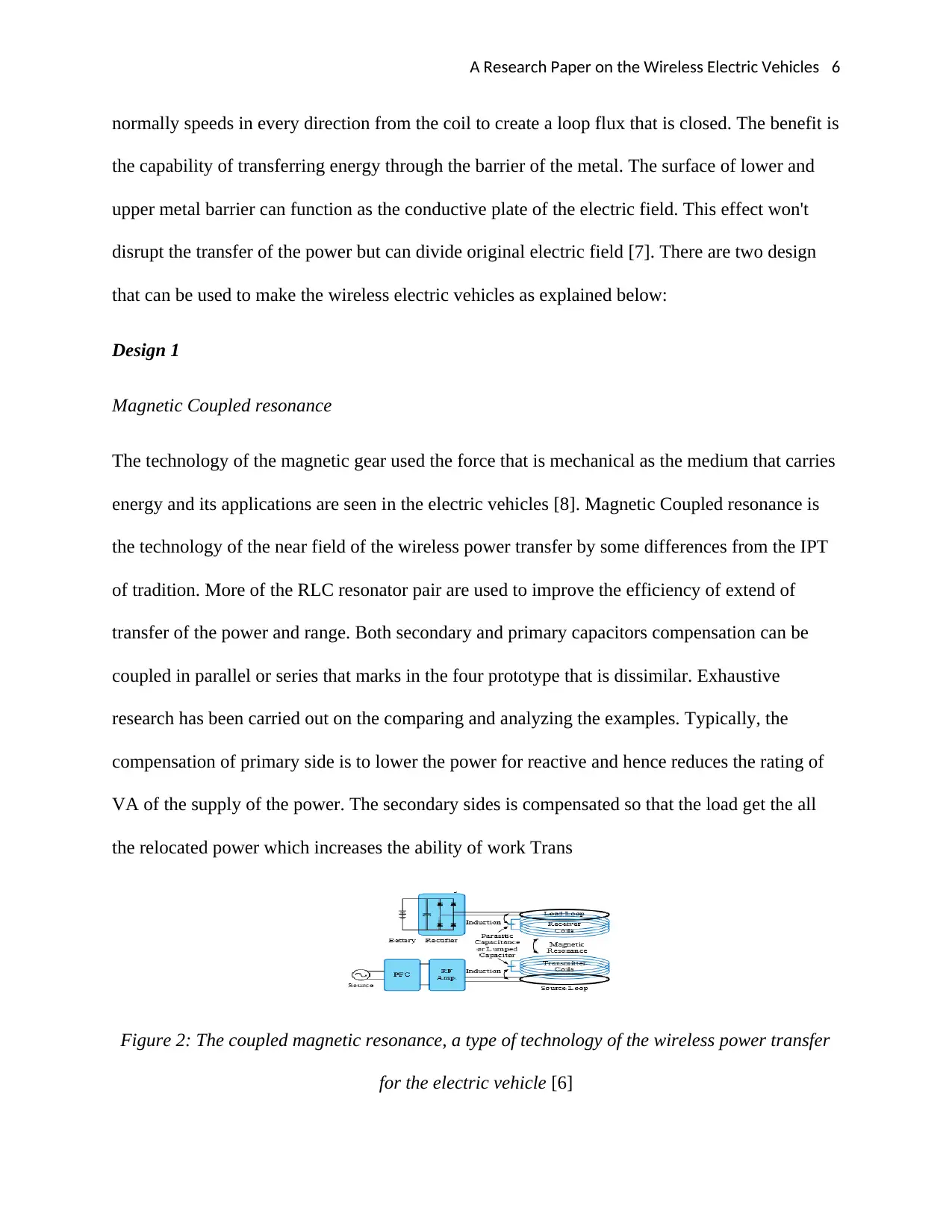
A Research Paper on the Wireless Electric Vehicles 6
normally speeds in every direction from the coil to create a loop flux that is closed. The benefit is
the capability of transferring energy through the barrier of the metal. The surface of lower and
upper metal barrier can function as the conductive plate of the electric field. This effect won't
disrupt the transfer of the power but can divide original electric field [7]. There are two design
that can be used to make the wireless electric vehicles as explained below:
Design 1
Magnetic Coupled resonance
The technology of the magnetic gear used the force that is mechanical as the medium that carries
energy and its applications are seen in the electric vehicles [8]. Magnetic Coupled resonance is
the technology of the near field of the wireless power transfer by some differences from the IPT
of tradition. More of the RLC resonator pair are used to improve the efficiency of extend of
transfer of the power and range. Both secondary and primary capacitors compensation can be
coupled in parallel or series that marks in the four prototype that is dissimilar. Exhaustive
research has been carried out on the comparing and analyzing the examples. Typically, the
compensation of primary side is to lower the power for reactive and hence reduces the rating of
VA of the supply of the power. The secondary sides is compensated so that the load get the all
the relocated power which increases the ability of work Trans
Figure 2: The coupled magnetic resonance, a type of technology of the wireless power transfer
for the electric vehicle [6]
normally speeds in every direction from the coil to create a loop flux that is closed. The benefit is
the capability of transferring energy through the barrier of the metal. The surface of lower and
upper metal barrier can function as the conductive plate of the electric field. This effect won't
disrupt the transfer of the power but can divide original electric field [7]. There are two design
that can be used to make the wireless electric vehicles as explained below:
Design 1
Magnetic Coupled resonance
The technology of the magnetic gear used the force that is mechanical as the medium that carries
energy and its applications are seen in the electric vehicles [8]. Magnetic Coupled resonance is
the technology of the near field of the wireless power transfer by some differences from the IPT
of tradition. More of the RLC resonator pair are used to improve the efficiency of extend of
transfer of the power and range. Both secondary and primary capacitors compensation can be
coupled in parallel or series that marks in the four prototype that is dissimilar. Exhaustive
research has been carried out on the comparing and analyzing the examples. Typically, the
compensation of primary side is to lower the power for reactive and hence reduces the rating of
VA of the supply of the power. The secondary sides is compensated so that the load get the all
the relocated power which increases the ability of work Trans
Figure 2: The coupled magnetic resonance, a type of technology of the wireless power transfer
for the electric vehicle [6]
⊘ This is a preview!⊘
Do you want full access?
Subscribe today to unlock all pages.

Trusted by 1+ million students worldwide
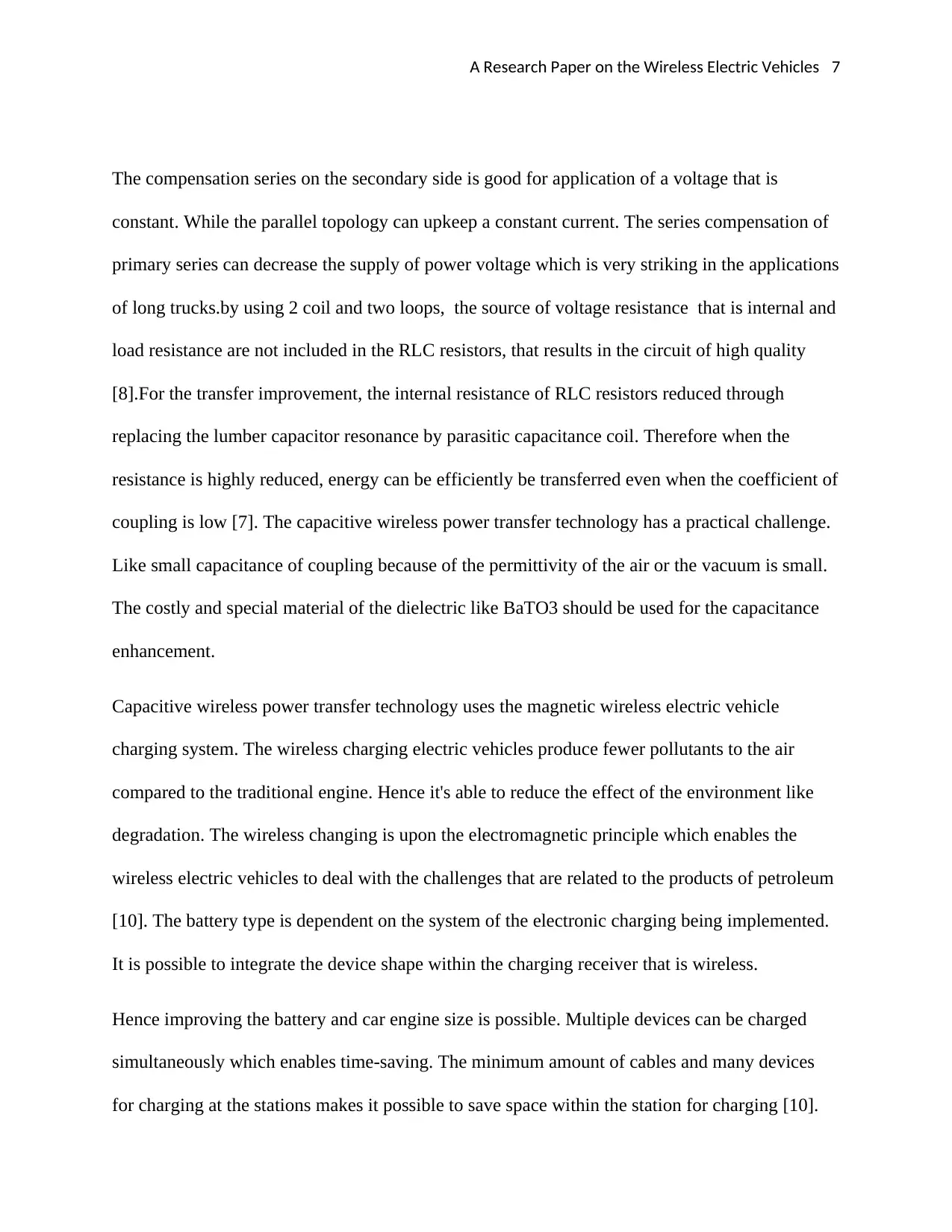
A Research Paper on the Wireless Electric Vehicles 7
The compensation series on the secondary side is good for application of a voltage that is
constant. While the parallel topology can upkeep a constant current. The series compensation of
primary series can decrease the supply of power voltage which is very striking in the applications
of long trucks.by using 2 coil and two loops, the source of voltage resistance that is internal and
load resistance are not included in the RLC resistors, that results in the circuit of high quality
[8].For the transfer improvement, the internal resistance of RLC resistors reduced through
replacing the lumber capacitor resonance by parasitic capacitance coil. Therefore when the
resistance is highly reduced, energy can be efficiently be transferred even when the coefficient of
coupling is low [7]. The capacitive wireless power transfer technology has a practical challenge.
Like small capacitance of coupling because of the permittivity of the air or the vacuum is small.
The costly and special material of the dielectric like BaTO3 should be used for the capacitance
enhancement.
Capacitive wireless power transfer technology uses the magnetic wireless electric vehicle
charging system. The wireless charging electric vehicles produce fewer pollutants to the air
compared to the traditional engine. Hence it's able to reduce the effect of the environment like
degradation. The wireless changing is upon the electromagnetic principle which enables the
wireless electric vehicles to deal with the challenges that are related to the products of petroleum
[10]. The battery type is dependent on the system of the electronic charging being implemented.
It is possible to integrate the device shape within the charging receiver that is wireless.
Hence improving the battery and car engine size is possible. Multiple devices can be charged
simultaneously which enables time-saving. The minimum amount of cables and many devices
for charging at the stations makes it possible to save space within the station for charging [10].
The compensation series on the secondary side is good for application of a voltage that is
constant. While the parallel topology can upkeep a constant current. The series compensation of
primary series can decrease the supply of power voltage which is very striking in the applications
of long trucks.by using 2 coil and two loops, the source of voltage resistance that is internal and
load resistance are not included in the RLC resistors, that results in the circuit of high quality
[8].For the transfer improvement, the internal resistance of RLC resistors reduced through
replacing the lumber capacitor resonance by parasitic capacitance coil. Therefore when the
resistance is highly reduced, energy can be efficiently be transferred even when the coefficient of
coupling is low [7]. The capacitive wireless power transfer technology has a practical challenge.
Like small capacitance of coupling because of the permittivity of the air or the vacuum is small.
The costly and special material of the dielectric like BaTO3 should be used for the capacitance
enhancement.
Capacitive wireless power transfer technology uses the magnetic wireless electric vehicle
charging system. The wireless charging electric vehicles produce fewer pollutants to the air
compared to the traditional engine. Hence it's able to reduce the effect of the environment like
degradation. The wireless changing is upon the electromagnetic principle which enables the
wireless electric vehicles to deal with the challenges that are related to the products of petroleum
[10]. The battery type is dependent on the system of the electronic charging being implemented.
It is possible to integrate the device shape within the charging receiver that is wireless.
Hence improving the battery and car engine size is possible. Multiple devices can be charged
simultaneously which enables time-saving. The minimum amount of cables and many devices
for charging at the stations makes it possible to save space within the station for charging [10].
Paraphrase This Document
Need a fresh take? Get an instant paraphrase of this document with our AI Paraphraser
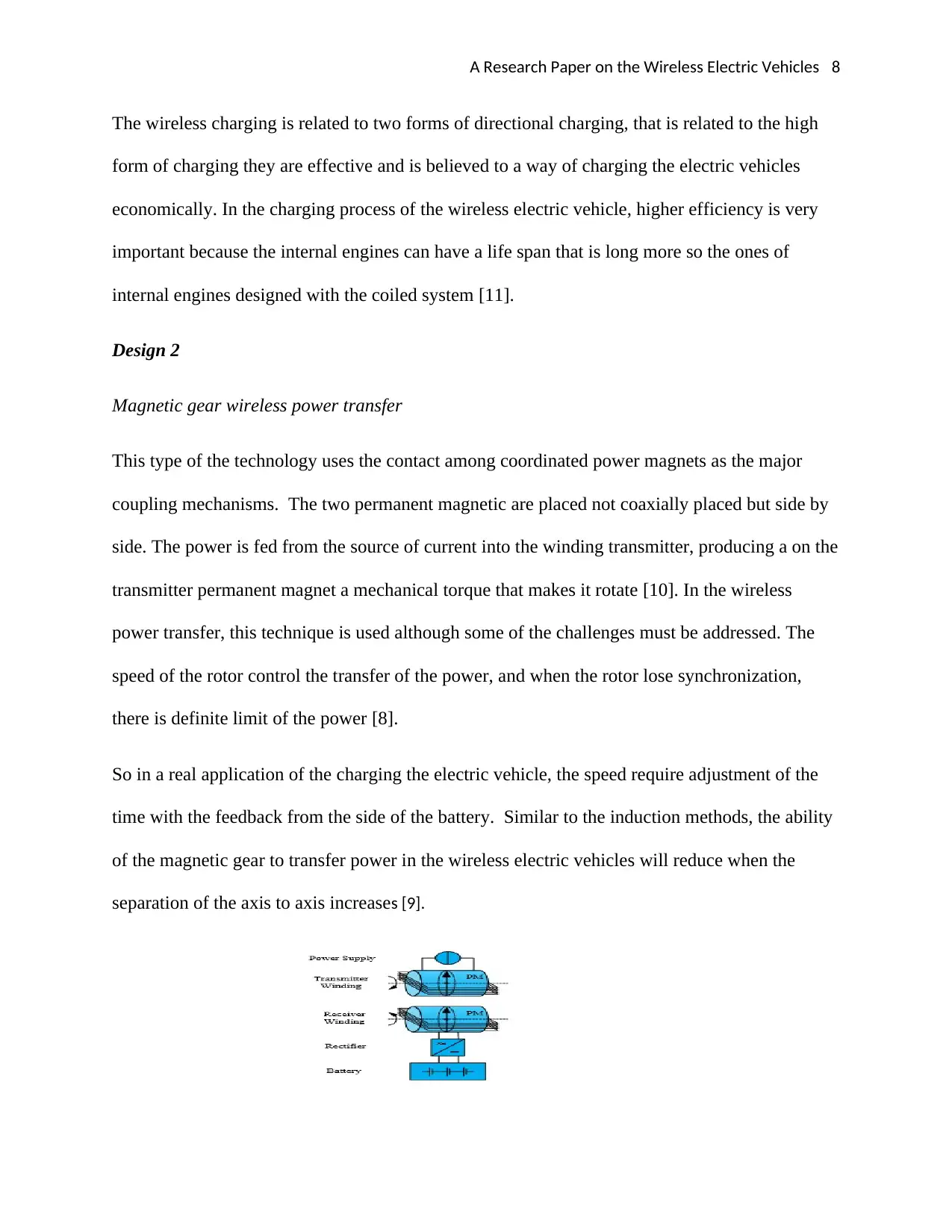
A Research Paper on the Wireless Electric Vehicles 8
The wireless charging is related to two forms of directional charging, that is related to the high
form of charging they are effective and is believed to a way of charging the electric vehicles
economically. In the charging process of the wireless electric vehicle, higher efficiency is very
important because the internal engines can have a life span that is long more so the ones of
internal engines designed with the coiled system [11].
Design 2
Magnetic gear wireless power transfer
This type of the technology uses the contact among coordinated power magnets as the major
coupling mechanisms. The two permanent magnetic are placed not coaxially placed but side by
side. The power is fed from the source of current into the winding transmitter, producing a on the
transmitter permanent magnet a mechanical torque that makes it rotate [10]. In the wireless
power transfer, this technique is used although some of the challenges must be addressed. The
speed of the rotor control the transfer of the power, and when the rotor lose synchronization,
there is definite limit of the power [8].
So in a real application of the charging the electric vehicle, the speed require adjustment of the
time with the feedback from the side of the battery. Similar to the induction methods, the ability
of the magnetic gear to transfer power in the wireless electric vehicles will reduce when the
separation of the axis to axis increases [9].
The wireless charging is related to two forms of directional charging, that is related to the high
form of charging they are effective and is believed to a way of charging the electric vehicles
economically. In the charging process of the wireless electric vehicle, higher efficiency is very
important because the internal engines can have a life span that is long more so the ones of
internal engines designed with the coiled system [11].
Design 2
Magnetic gear wireless power transfer
This type of the technology uses the contact among coordinated power magnets as the major
coupling mechanisms. The two permanent magnetic are placed not coaxially placed but side by
side. The power is fed from the source of current into the winding transmitter, producing a on the
transmitter permanent magnet a mechanical torque that makes it rotate [10]. In the wireless
power transfer, this technique is used although some of the challenges must be addressed. The
speed of the rotor control the transfer of the power, and when the rotor lose synchronization,
there is definite limit of the power [8].
So in a real application of the charging the electric vehicle, the speed require adjustment of the
time with the feedback from the side of the battery. Similar to the induction methods, the ability
of the magnetic gear to transfer power in the wireless electric vehicles will reduce when the
separation of the axis to axis increases [9].
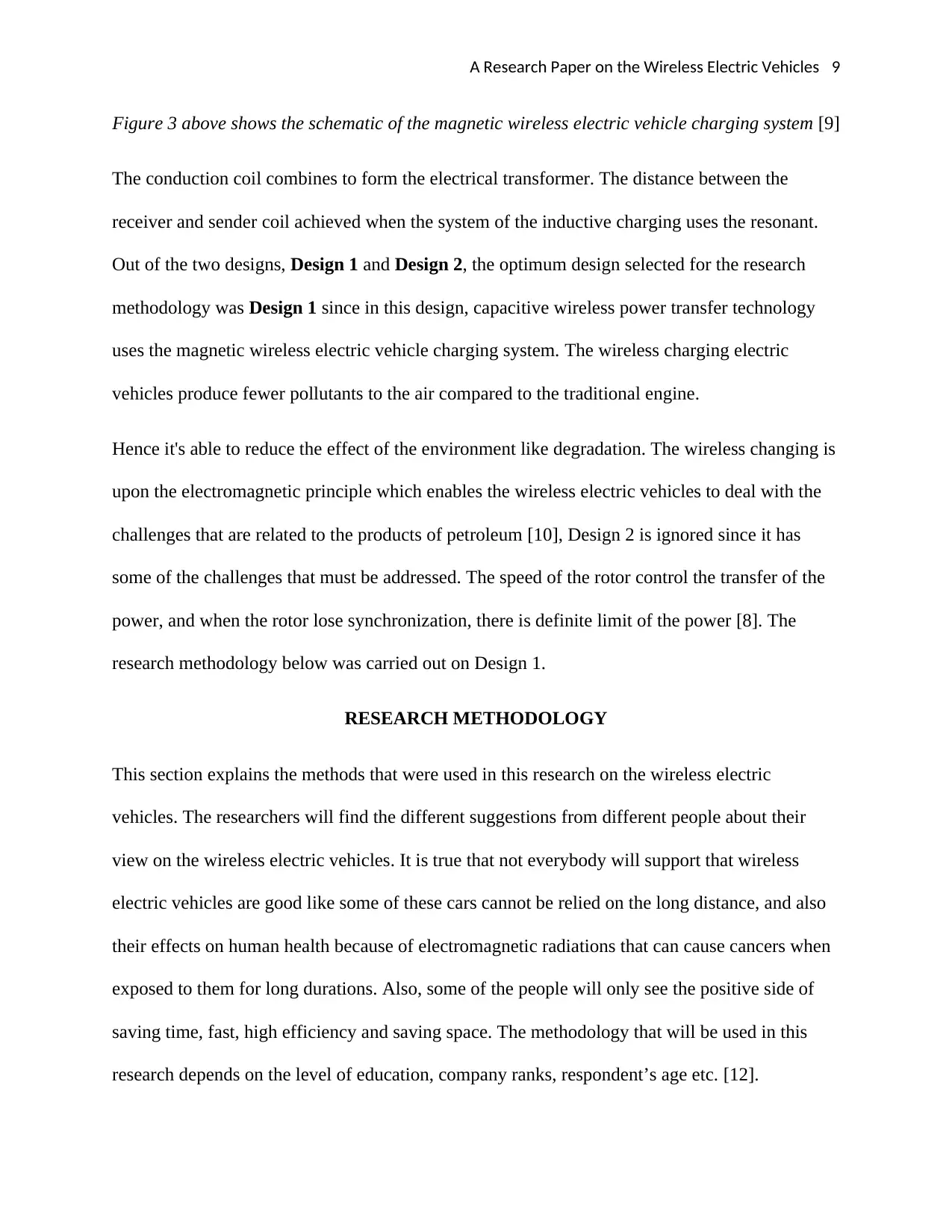
A Research Paper on the Wireless Electric Vehicles 9
Figure 3 above shows the schematic of the magnetic wireless electric vehicle charging system [9]
The conduction coil combines to form the electrical transformer. The distance between the
receiver and sender coil achieved when the system of the inductive charging uses the resonant.
Out of the two designs, Design 1 and Design 2, the optimum design selected for the research
methodology was Design 1 since in this design, capacitive wireless power transfer technology
uses the magnetic wireless electric vehicle charging system. The wireless charging electric
vehicles produce fewer pollutants to the air compared to the traditional engine.
Hence it's able to reduce the effect of the environment like degradation. The wireless changing is
upon the electromagnetic principle which enables the wireless electric vehicles to deal with the
challenges that are related to the products of petroleum [10], Design 2 is ignored since it has
some of the challenges that must be addressed. The speed of the rotor control the transfer of the
power, and when the rotor lose synchronization, there is definite limit of the power [8]. The
research methodology below was carried out on Design 1.
RESEARCH METHODOLOGY
This section explains the methods that were used in this research on the wireless electric
vehicles. The researchers will find the different suggestions from different people about their
view on the wireless electric vehicles. It is true that not everybody will support that wireless
electric vehicles are good like some of these cars cannot be relied on the long distance, and also
their effects on human health because of electromagnetic radiations that can cause cancers when
exposed to them for long durations. Also, some of the people will only see the positive side of
saving time, fast, high efficiency and saving space. The methodology that will be used in this
research depends on the level of education, company ranks, respondent’s age etc. [12].
Figure 3 above shows the schematic of the magnetic wireless electric vehicle charging system [9]
The conduction coil combines to form the electrical transformer. The distance between the
receiver and sender coil achieved when the system of the inductive charging uses the resonant.
Out of the two designs, Design 1 and Design 2, the optimum design selected for the research
methodology was Design 1 since in this design, capacitive wireless power transfer technology
uses the magnetic wireless electric vehicle charging system. The wireless charging electric
vehicles produce fewer pollutants to the air compared to the traditional engine.
Hence it's able to reduce the effect of the environment like degradation. The wireless changing is
upon the electromagnetic principle which enables the wireless electric vehicles to deal with the
challenges that are related to the products of petroleum [10], Design 2 is ignored since it has
some of the challenges that must be addressed. The speed of the rotor control the transfer of the
power, and when the rotor lose synchronization, there is definite limit of the power [8]. The
research methodology below was carried out on Design 1.
RESEARCH METHODOLOGY
This section explains the methods that were used in this research on the wireless electric
vehicles. The researchers will find the different suggestions from different people about their
view on the wireless electric vehicles. It is true that not everybody will support that wireless
electric vehicles are good like some of these cars cannot be relied on the long distance, and also
their effects on human health because of electromagnetic radiations that can cause cancers when
exposed to them for long durations. Also, some of the people will only see the positive side of
saving time, fast, high efficiency and saving space. The methodology that will be used in this
research depends on the level of education, company ranks, respondent’s age etc. [12].
⊘ This is a preview!⊘
Do you want full access?
Subscribe today to unlock all pages.

Trusted by 1+ million students worldwide
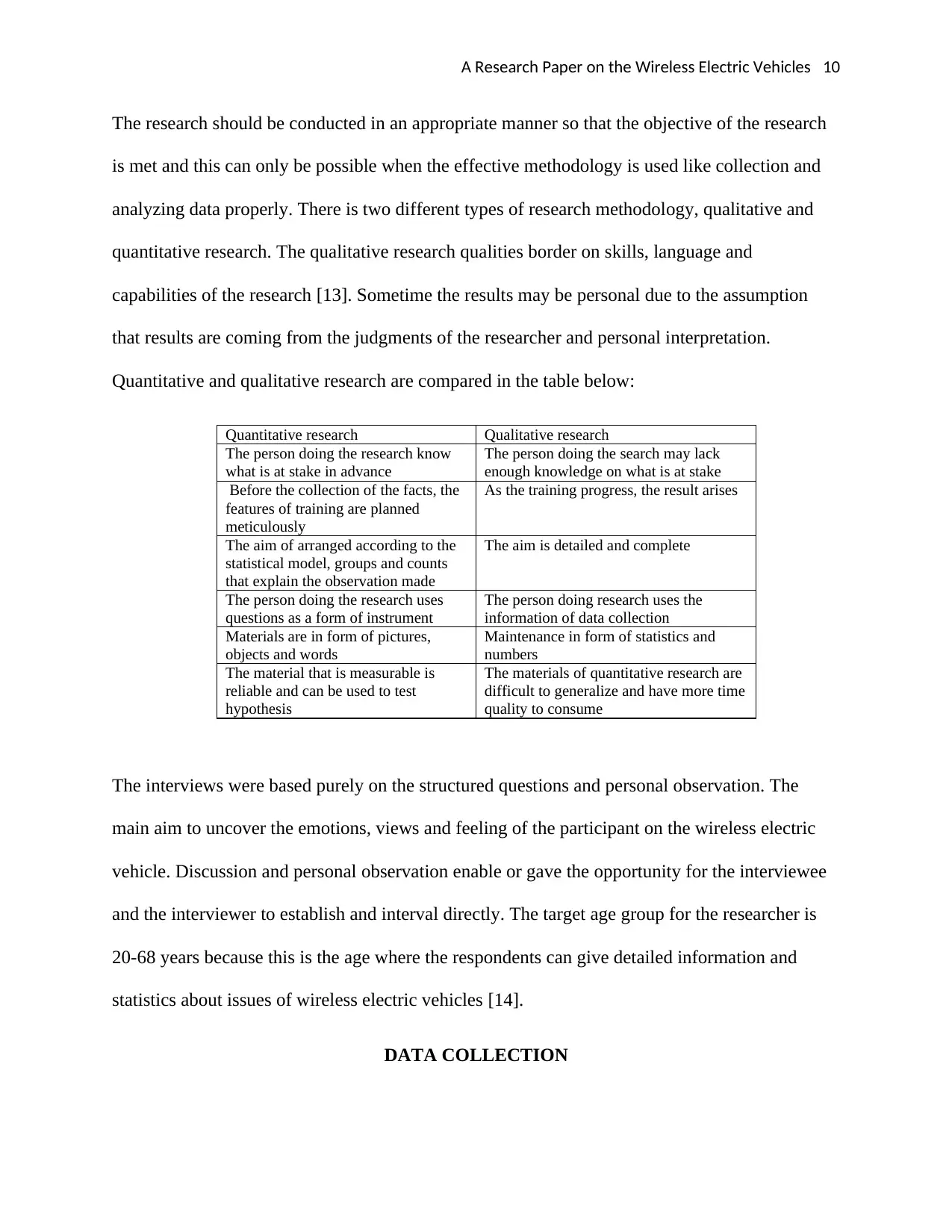
A Research Paper on the Wireless Electric Vehicles 10
The research should be conducted in an appropriate manner so that the objective of the research
is met and this can only be possible when the effective methodology is used like collection and
analyzing data properly. There is two different types of research methodology, qualitative and
quantitative research. The qualitative research qualities border on skills, language and
capabilities of the research [13]. Sometime the results may be personal due to the assumption
that results are coming from the judgments of the researcher and personal interpretation.
Quantitative and qualitative research are compared in the table below:
Quantitative research Qualitative research
The person doing the research know
what is at stake in advance
The person doing the search may lack
enough knowledge on what is at stake
Before the collection of the facts, the
features of training are planned
meticulously
As the training progress, the result arises
The aim of arranged according to the
statistical model, groups and counts
that explain the observation made
The aim is detailed and complete
The person doing the research uses
questions as a form of instrument
The person doing research uses the
information of data collection
Materials are in form of pictures,
objects and words
Maintenance in form of statistics and
numbers
The material that is measurable is
reliable and can be used to test
hypothesis
The materials of quantitative research are
difficult to generalize and have more time
quality to consume
The interviews were based purely on the structured questions and personal observation. The
main aim to uncover the emotions, views and feeling of the participant on the wireless electric
vehicle. Discussion and personal observation enable or gave the opportunity for the interviewee
and the interviewer to establish and interval directly. The target age group for the researcher is
20-68 years because this is the age where the respondents can give detailed information and
statistics about issues of wireless electric vehicles [14].
DATA COLLECTION
The research should be conducted in an appropriate manner so that the objective of the research
is met and this can only be possible when the effective methodology is used like collection and
analyzing data properly. There is two different types of research methodology, qualitative and
quantitative research. The qualitative research qualities border on skills, language and
capabilities of the research [13]. Sometime the results may be personal due to the assumption
that results are coming from the judgments of the researcher and personal interpretation.
Quantitative and qualitative research are compared in the table below:
Quantitative research Qualitative research
The person doing the research know
what is at stake in advance
The person doing the search may lack
enough knowledge on what is at stake
Before the collection of the facts, the
features of training are planned
meticulously
As the training progress, the result arises
The aim of arranged according to the
statistical model, groups and counts
that explain the observation made
The aim is detailed and complete
The person doing the research uses
questions as a form of instrument
The person doing research uses the
information of data collection
Materials are in form of pictures,
objects and words
Maintenance in form of statistics and
numbers
The material that is measurable is
reliable and can be used to test
hypothesis
The materials of quantitative research are
difficult to generalize and have more time
quality to consume
The interviews were based purely on the structured questions and personal observation. The
main aim to uncover the emotions, views and feeling of the participant on the wireless electric
vehicle. Discussion and personal observation enable or gave the opportunity for the interviewee
and the interviewer to establish and interval directly. The target age group for the researcher is
20-68 years because this is the age where the respondents can give detailed information and
statistics about issues of wireless electric vehicles [14].
DATA COLLECTION
Paraphrase This Document
Need a fresh take? Get an instant paraphrase of this document with our AI Paraphraser
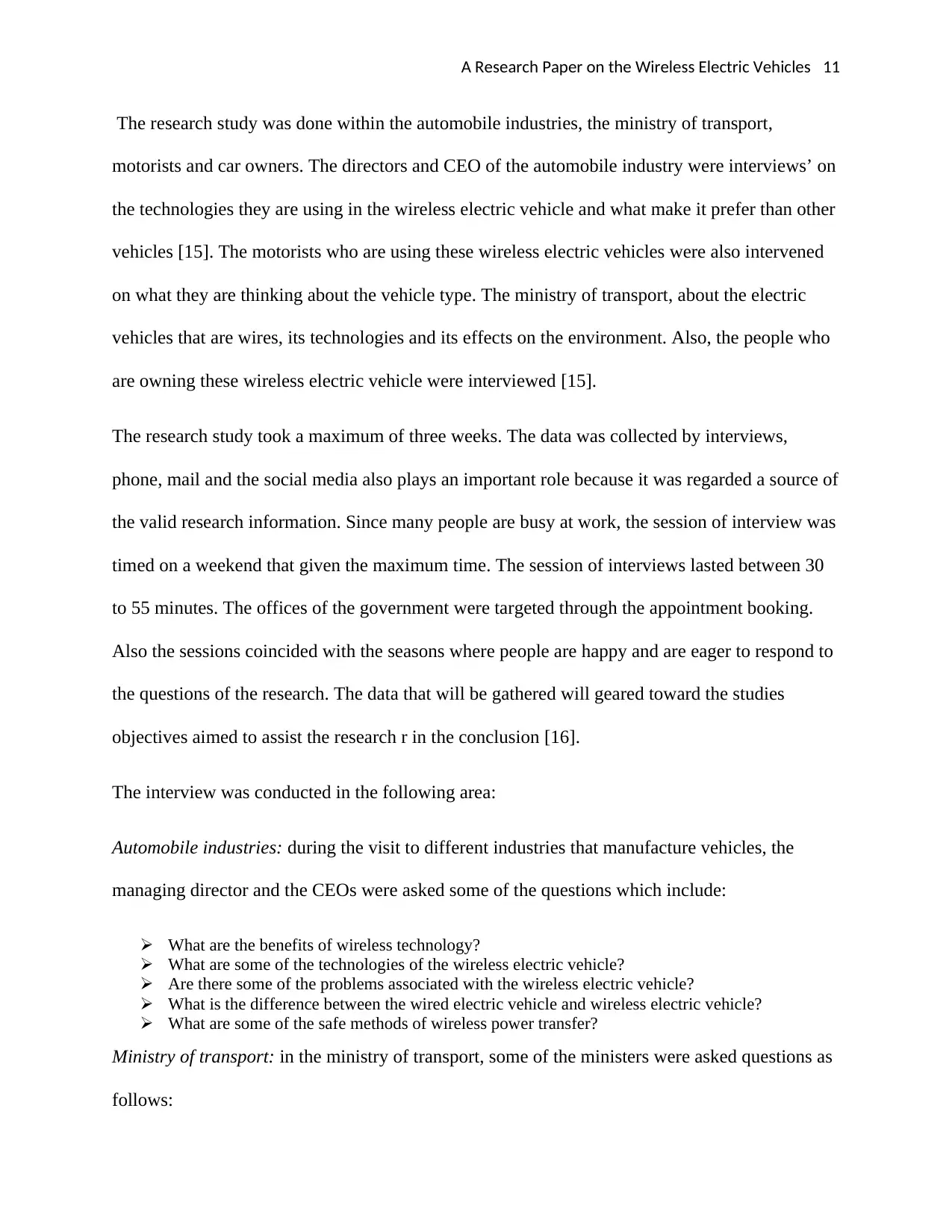
A Research Paper on the Wireless Electric Vehicles 11
The research study was done within the automobile industries, the ministry of transport,
motorists and car owners. The directors and CEO of the automobile industry were interviews’ on
the technologies they are using in the wireless electric vehicle and what make it prefer than other
vehicles [15]. The motorists who are using these wireless electric vehicles were also intervened
on what they are thinking about the vehicle type. The ministry of transport, about the electric
vehicles that are wires, its technologies and its effects on the environment. Also, the people who
are owning these wireless electric vehicle were interviewed [15].
The research study took a maximum of three weeks. The data was collected by interviews,
phone, mail and the social media also plays an important role because it was regarded a source of
the valid research information. Since many people are busy at work, the session of interview was
timed on a weekend that given the maximum time. The session of interviews lasted between 30
to 55 minutes. The offices of the government were targeted through the appointment booking.
Also the sessions coincided with the seasons where people are happy and are eager to respond to
the questions of the research. The data that will be gathered will geared toward the studies
objectives aimed to assist the research r in the conclusion [16].
The interview was conducted in the following area:
Automobile industries: during the visit to different industries that manufacture vehicles, the
managing director and the CEOs were asked some of the questions which include:
What are the benefits of wireless technology?
What are some of the technologies of the wireless electric vehicle?
Are there some of the problems associated with the wireless electric vehicle?
What is the difference between the wired electric vehicle and wireless electric vehicle?
What are some of the safe methods of wireless power transfer?
Ministry of transport: in the ministry of transport, some of the ministers were asked questions as
follows:
The research study was done within the automobile industries, the ministry of transport,
motorists and car owners. The directors and CEO of the automobile industry were interviews’ on
the technologies they are using in the wireless electric vehicle and what make it prefer than other
vehicles [15]. The motorists who are using these wireless electric vehicles were also intervened
on what they are thinking about the vehicle type. The ministry of transport, about the electric
vehicles that are wires, its technologies and its effects on the environment. Also, the people who
are owning these wireless electric vehicle were interviewed [15].
The research study took a maximum of three weeks. The data was collected by interviews,
phone, mail and the social media also plays an important role because it was regarded a source of
the valid research information. Since many people are busy at work, the session of interview was
timed on a weekend that given the maximum time. The session of interviews lasted between 30
to 55 minutes. The offices of the government were targeted through the appointment booking.
Also the sessions coincided with the seasons where people are happy and are eager to respond to
the questions of the research. The data that will be gathered will geared toward the studies
objectives aimed to assist the research r in the conclusion [16].
The interview was conducted in the following area:
Automobile industries: during the visit to different industries that manufacture vehicles, the
managing director and the CEOs were asked some of the questions which include:
What are the benefits of wireless technology?
What are some of the technologies of the wireless electric vehicle?
Are there some of the problems associated with the wireless electric vehicle?
What is the difference between the wired electric vehicle and wireless electric vehicle?
What are some of the safe methods of wireless power transfer?
Ministry of transport: in the ministry of transport, some of the ministers were asked questions as
follows:
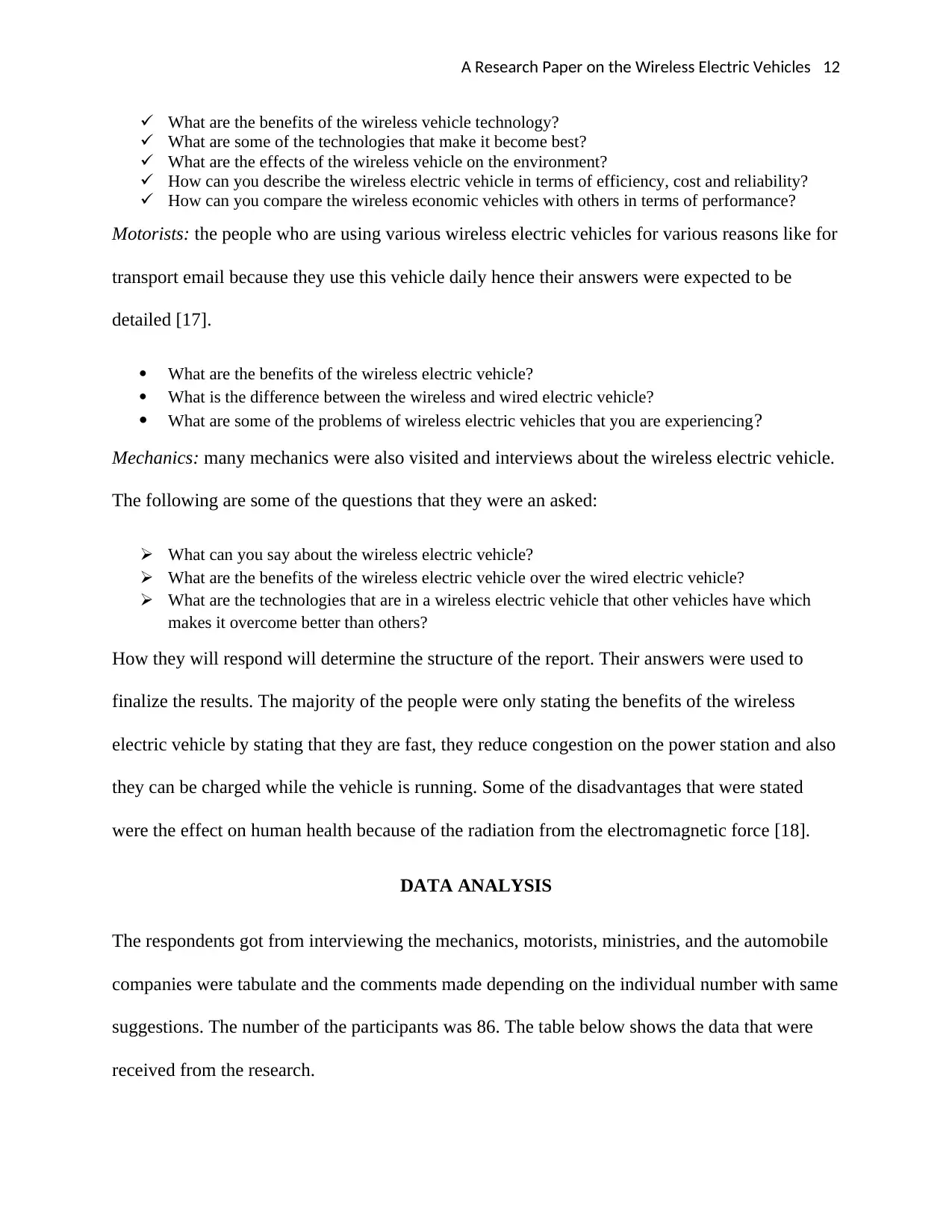
A Research Paper on the Wireless Electric Vehicles 12
What are the benefits of the wireless vehicle technology?
What are some of the technologies that make it become best?
What are the effects of the wireless vehicle on the environment?
How can you describe the wireless electric vehicle in terms of efficiency, cost and reliability?
How can you compare the wireless economic vehicles with others in terms of performance?
Motorists: the people who are using various wireless electric vehicles for various reasons like for
transport email because they use this vehicle daily hence their answers were expected to be
detailed [17].
What are the benefits of the wireless electric vehicle?
What is the difference between the wireless and wired electric vehicle?
What are some of the problems of wireless electric vehicles that you are experiencing?
Mechanics: many mechanics were also visited and interviews about the wireless electric vehicle.
The following are some of the questions that they were an asked:
What can you say about the wireless electric vehicle?
What are the benefits of the wireless electric vehicle over the wired electric vehicle?
What are the technologies that are in a wireless electric vehicle that other vehicles have which
makes it overcome better than others?
How they will respond will determine the structure of the report. Their answers were used to
finalize the results. The majority of the people were only stating the benefits of the wireless
electric vehicle by stating that they are fast, they reduce congestion on the power station and also
they can be charged while the vehicle is running. Some of the disadvantages that were stated
were the effect on human health because of the radiation from the electromagnetic force [18].
DATA ANALYSIS
The respondents got from interviewing the mechanics, motorists, ministries, and the automobile
companies were tabulate and the comments made depending on the individual number with same
suggestions. The number of the participants was 86. The table below shows the data that were
received from the research.
What are the benefits of the wireless vehicle technology?
What are some of the technologies that make it become best?
What are the effects of the wireless vehicle on the environment?
How can you describe the wireless electric vehicle in terms of efficiency, cost and reliability?
How can you compare the wireless economic vehicles with others in terms of performance?
Motorists: the people who are using various wireless electric vehicles for various reasons like for
transport email because they use this vehicle daily hence their answers were expected to be
detailed [17].
What are the benefits of the wireless electric vehicle?
What is the difference between the wireless and wired electric vehicle?
What are some of the problems of wireless electric vehicles that you are experiencing?
Mechanics: many mechanics were also visited and interviews about the wireless electric vehicle.
The following are some of the questions that they were an asked:
What can you say about the wireless electric vehicle?
What are the benefits of the wireless electric vehicle over the wired electric vehicle?
What are the technologies that are in a wireless electric vehicle that other vehicles have which
makes it overcome better than others?
How they will respond will determine the structure of the report. Their answers were used to
finalize the results. The majority of the people were only stating the benefits of the wireless
electric vehicle by stating that they are fast, they reduce congestion on the power station and also
they can be charged while the vehicle is running. Some of the disadvantages that were stated
were the effect on human health because of the radiation from the electromagnetic force [18].
DATA ANALYSIS
The respondents got from interviewing the mechanics, motorists, ministries, and the automobile
companies were tabulate and the comments made depending on the individual number with same
suggestions. The number of the participants was 86. The table below shows the data that were
received from the research.
⊘ This is a preview!⊘
Do you want full access?
Subscribe today to unlock all pages.

Trusted by 1+ million students worldwide
1 out of 19
Related Documents
Your All-in-One AI-Powered Toolkit for Academic Success.
+13062052269
info@desklib.com
Available 24*7 on WhatsApp / Email
![[object Object]](/_next/static/media/star-bottom.7253800d.svg)
Unlock your academic potential
Copyright © 2020–2025 A2Z Services. All Rights Reserved. Developed and managed by ZUCOL.


![Hybrid and Electric Vehicles: Battery Power Report - [University Name]](/_next/image/?url=https%3A%2F%2Fdesklib.com%2Fmedia%2Fimages%2Foz%2Fe29569c874f844d2874f09f043debbd5.jpg&w=256&q=75)


